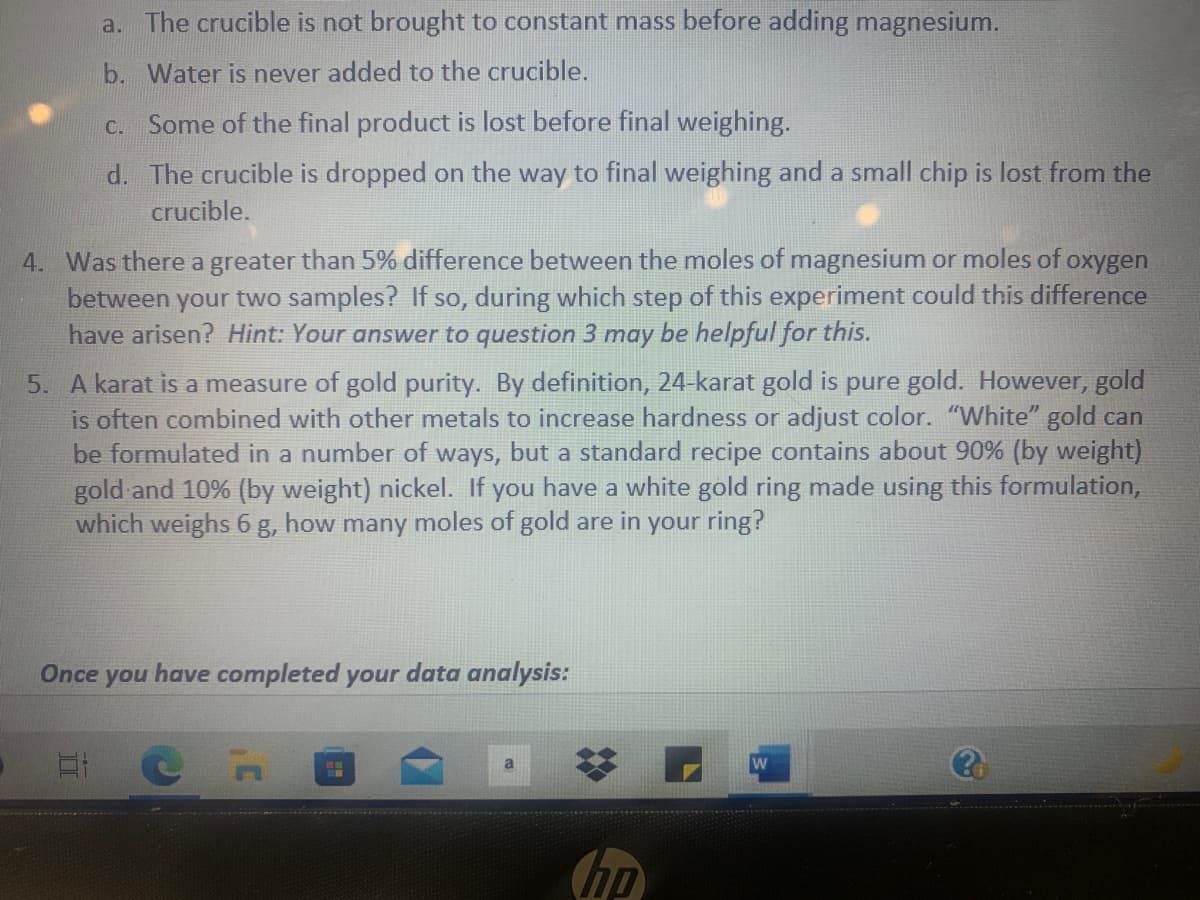A karat is a measure of gold purity. By definition, 24-karat gold is pure gold. However, gold is often combined with other metals to increase hardness or adjust color. "White" gold can be formulated in a number of ways, but a standard recipe contains about 90% (by weight) gold and 10% (by weight) nickel. If you have a white gold ring made using this formulation, which weighs 6 g, how many moles of gold are in your ring?
A karat is a measure of gold purity. By definition, 24-karat gold is pure gold. However, gold is often combined with other metals to increase hardness or adjust color. "White" gold can be formulated in a number of ways, but a standard recipe contains about 90% (by weight) gold and 10% (by weight) nickel. If you have a white gold ring made using this formulation, which weighs 6 g, how many moles of gold are in your ring?
Introductory Chemistry: A Foundation
9th Edition
ISBN:9781337399425
Author:Steven S. Zumdahl, Donald J. DeCoste
Publisher:Steven S. Zumdahl, Donald J. DeCoste
Chapter9: Chemical Quantities
Section: Chapter Questions
Problem 36QAP
Related questions
Question
100%
Number 5

Transcribed Image Text:a. The crucible is not brought to constant mass before adding magnesium.
b. Water is never added to the crucible.
Some of the final product is lost before final weighing.
C.
d. The crucible is dropped on the way to final weighing and a small chip is lost from the
crucible.
4. Was there a greater than 5% difference between the moles of magnesium or moles of oxygen
between your two samples? If so, during which step of this experiment could this difference
have arisen? Hint: Your answer to question 3 may be helpful for this.
5. A karat is a measure of gold purity. By definition, 24-karat gold is pure gold. However, gold
is often combined with other metals to increase hardness or adjust color. "White" gold can
be formulated in a number of ways, but a standard recipe contains about 90% (by weight)
gold and 10% (by weight) nickel. If you have a white gold ring made using this formulation,
which weighs 6 g, how many moles of gold are in your ring?
Once
you
have completed your data analysis:
hp
Expert Solution
This question has been solved!
Explore an expertly crafted, step-by-step solution for a thorough understanding of key concepts.
This is a popular solution!
Trending now
This is a popular solution!
Step by step
Solved in 2 steps

Knowledge Booster
Learn more about
Need a deep-dive on the concept behind this application? Look no further. Learn more about this topic, chemistry and related others by exploring similar questions and additional content below.Recommended textbooks for you

Introductory Chemistry: A Foundation
Chemistry
ISBN:
9781337399425
Author:
Steven S. Zumdahl, Donald J. DeCoste
Publisher:
Cengage Learning

Chemistry: Principles and Reactions
Chemistry
ISBN:
9781305079373
Author:
William L. Masterton, Cecile N. Hurley
Publisher:
Cengage Learning

Chemistry for Engineering Students
Chemistry
ISBN:
9781337398909
Author:
Lawrence S. Brown, Tom Holme
Publisher:
Cengage Learning

Introductory Chemistry: A Foundation
Chemistry
ISBN:
9781337399425
Author:
Steven S. Zumdahl, Donald J. DeCoste
Publisher:
Cengage Learning

Chemistry: Principles and Reactions
Chemistry
ISBN:
9781305079373
Author:
William L. Masterton, Cecile N. Hurley
Publisher:
Cengage Learning

Chemistry for Engineering Students
Chemistry
ISBN:
9781337398909
Author:
Lawrence S. Brown, Tom Holme
Publisher:
Cengage Learning

Chemistry: Matter and Change
Chemistry
ISBN:
9780078746376
Author:
Dinah Zike, Laurel Dingrando, Nicholas Hainen, Cheryl Wistrom
Publisher:
Glencoe/McGraw-Hill School Pub Co

Principles of Modern Chemistry
Chemistry
ISBN:
9781305079113
Author:
David W. Oxtoby, H. Pat Gillis, Laurie J. Butler
Publisher:
Cengage Learning

Chemistry by OpenStax (2015-05-04)
Chemistry
ISBN:
9781938168390
Author:
Klaus Theopold, Richard H Langley, Paul Flowers, William R. Robinson, Mark Blaser
Publisher:
OpenStax